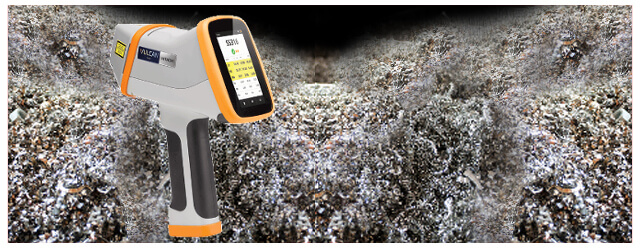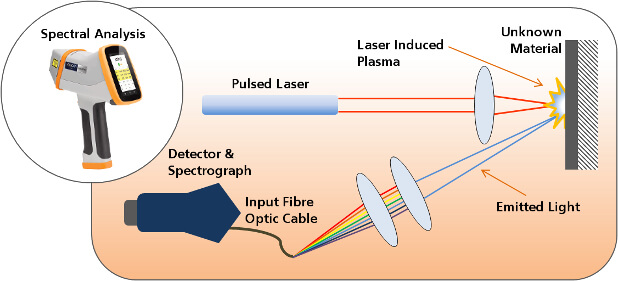
What is LIBS (Laser-induced breakdown spectroscopy)?
Laser-Induced Breakdown Spectroscopy (LIBS) is becoming a popular analytical technique, which can potentially measure all elements in the periodic table, in samples of all types (gas, solids, liquids). LIBS is important in applications such as the recycling of scrap metals and alloys where it can be used to quickly identify a large number of items. No other material analysis technique can match the performance of LIBS in this area.
The basic principle is illustrated in the schematic diagram. Each laser pulse hits the surface of the material to be analysed causing a tiny amount of the sample to be ablated. This tiny amount of material is heated up to a high temperature, forming a plasma at the surface of the sample. In the plasma, atoms are energized, forming atomic and ionic species of the present elements - the plasma forms with temperatures of 10,000°C at the sample surface.
After each pulse the plasma cools and characteristic light emissions can be observed as the energised ions return to their original atomic state. The light emissions are collected through a fibre optic cable, and processed by the spectrometer, applying advanced statistical methods to generate reproducible, reliable results for each analysis to give the sample’s elemental composition and alloy grade.

World's first
The LIBS portfolio includes mPulse, the world’s first LIBS handheld alloy sorter, capable of reliably identifying metal alloys in just one second. The mPulse is simple to use. No buttons: just press the trigger to switch the mPulse on and start the test. With LIBS there are no X-rays, so the mPulse is free from all the regulations governing the use of X-ray emitting products. This reduces the need for training and paperwork, making LIBS truly hassle free.
A (virtually) non-destructive technique
A microscopic amount of material is consumed – as little as 1 billionth of a gram (1 nanogram), leaving a tiny mark on the sample. During the pulse the power density at the sample surface can exceed 1 Gigawatt per cm2. However, the average power density of a test is less than 1 Watt – there is almost no sample heating surrounding the test area.
No sample preparation
LIBS is able to analyse a material directly without the need to prepare the sample beforehand. If the sample material is coated with another material (eg. oxidised or painted), the laser radiation may be used to initially clean the surface of the sample to expose the underlying material allowing chemical analysis to be carried out.
Application areas
- Ultra fast identification and sorting of scrap metals and alloys during recycling
- Positive Metal Identification (PMI) of components for good-inwards, manufacturing and assembly
- Compositional analysis of complex shape objects